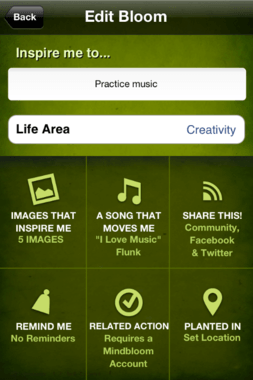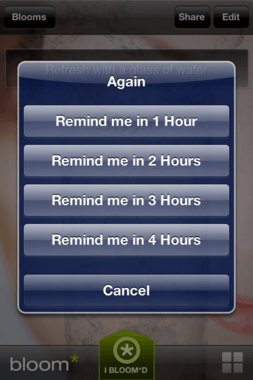The digital inspirations that are the foundation of the app are called (fittingly) Blooms, and the app comes pre-loaded with several of them. You can set reminders that will notify you when it’s time to “Bloom” them – and those reminders can be randomized or set for particular dates and times. You can associate different images from your iPhone with each Bloom, and do the same with music from your iTunes library. Each Bloom comes with imagery attached already, so you can choose to go with those defaults or pick photos from your own library that fit the Bloom best. As for musical selections for Blooms, each one comes with a preview of a suggested iTunes song (and offers a download link so you can grab it straight away), or you can go with your own song if you want. Blooms can also be shared socially via your Facebook and Twitter accounts, or can be sent to friends and family via email. Once shared, Blooms can be saved in the Bloom app, played, or be used as the starting point for a new, personalized Bloom. Here’s an example of how I’ve used varying privacy settings with Blooms: Bloom notifications are one of the things I really took advantage of during my testing of the app. It reminded me to reflect, take a break, or trigger an action that kept me focused on what mattered to me most. I’ve never been really good at keeping up with water intake, but Bloom has allowed me to do this. I’d never enter something like “Drink water” into my task management app of choice, but since I don’t look at Bloom in that manner, I’m able to do it here. What I consider Bloom to be is a life enhancement app, a companion piece that I can use (along with Mindbloom) to keep augment mindfulness while I let my task manager handle all of the other stuff. It’s part of my combined system, and it works well for me because each component does what it does better than the others. But why should you grab Bloom? And more importantly, why should you use it – or Mindbloom, for that matter? Unlike any productivity-type application I’ve seen, Mindbloom basically makes achieving what might be usually considered an ordinary thing quite an extraordinary digital experience. Parks Associates, an industry research firm, is studying a growing demand for health entertainment and lead analyst, Harry Wang believes Mindbloom can be just as entertaining as it is beneficial. “Many health and wellness applications often take a prescriptive approach when designing the user experience. But we’ve seen that people tend to become less engaged with these types of applications over time,” said Mr. Wang. “Mindbloom takes a more personal approach, entertaining even, which makes the overall experience more inviting, relevant and rewarding.” I had the opportunity to speak with Mindbloom founder Chris Hewett when Mindbloom first launched and just days before Bloom was scheduled to go public. What I discovered is that he is among those who are developing a new generation of productivity/task management apps that “gets it”. It brings to mind this quote, which, much like Steve Jobs, I’ve been a fan of: Hewett and his team are doing just that with the Mindbloom web app – and now, with Bloom on the iPhone. “Everyday, more than 250 million photos are uploaded to Facebook, Instagram recently celebrated 150 million photos being shared and iTunes recently surpassed 16 billion song downloads,” said Hewett, a former executive producer for Monolith Productions who developed blockbuster hits such as No One Lives Forever, Tron 2.0, and F.E.A.R. ”Photos and music are a powerful way to express ourselves and to share experiences, but we believe there’s an untapped opportunity to use photos, music and inspiring words to remind ourselves and express to others what matters most to us and what we’re doing about it.” As mentioned, Bloom can act as a standalone app, or can work in conjunction with the Mindbloom web app through the recently launched free-to-play “life game”, which serves to inspire people to define what’s important, discover what motivates them, and take meaningful daily actions in all areas of their life. Users can connect Bloom with their Mindbloom life game, where it builds on these goals by focusing on the science behind behavioral change – integrating technology, art, and human psychology to make personal growth more effective on-the-go. Bloom is now available as a free download in the iTunes App Store . I recommend you give it a look – it’s not your ordinary productivity and lifestyle app. In fact, it’s quite extraordinary.


